Management Accounting Report: Planning, Tools, and Methods
VerifiedAdded on 2023/01/19
|20
|5817
|59
Report
AI Summary
This report delves into the core concepts of management accounting, emphasizing its critical role in organizational decision-making and planning, contrasting it with financial accounting. It explores various management accounting systems, including inventory management (LIFO, FIFO, AVCO), cost accounting (job costing, process costing), and price optimization. The report highlights the importance of these systems in operational efficiency, cost control, and pricing strategies. It further examines various managerial accounting reporting methods such as budget, execution, inventory, manufacturing, job costing, performance, and accounts receivable reports, illustrating their significance in informed decision-making. The report also discusses the use of planning tools and the adaptation of management accounting systems in different organizations. The report concludes by highlighting the benefits of these systems, such as the AVCO technique for cost allocation in inventory management, which is particularly beneficial for companies like Corus. Overall, the report provides a comprehensive overview of management accounting principles and their practical applications in a business setting.
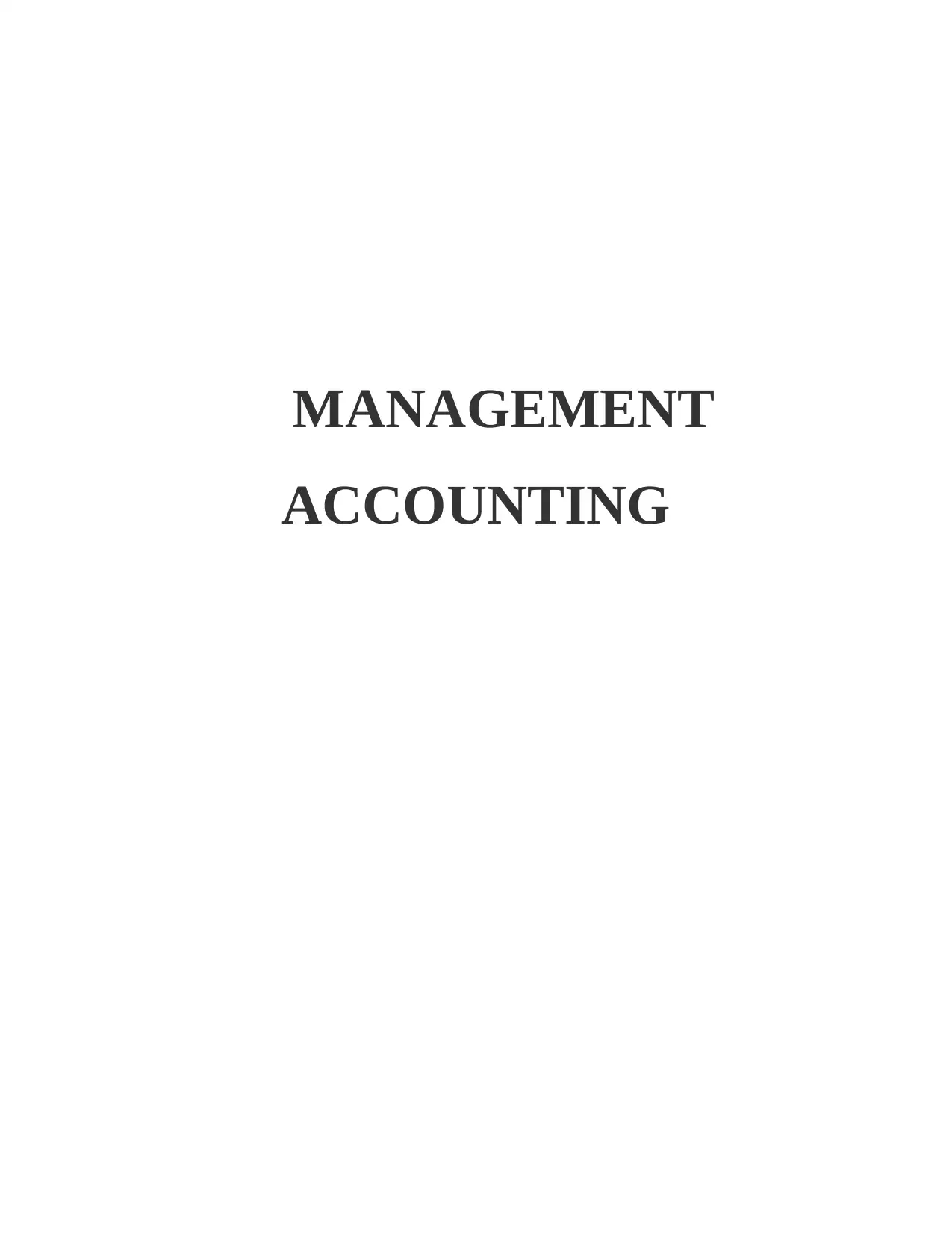
MANAGEMENT
ACCOUNTING
ACCOUNTING
Paraphrase This Document
Need a fresh take? Get an instant paraphrase of this document with our AI Paraphraser
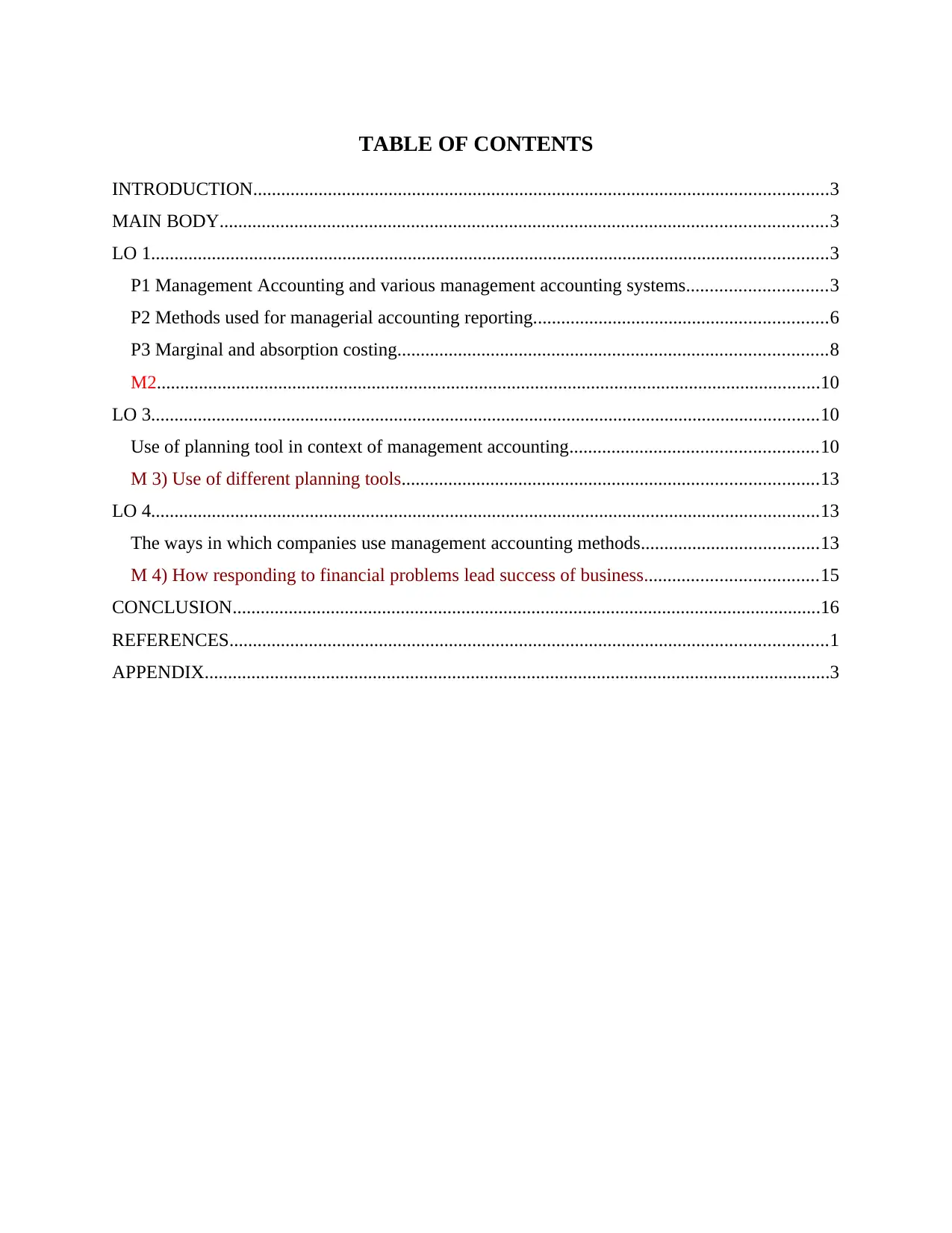
TABLE OF CONTENTS
INTRODUCTION...........................................................................................................................3
MAIN BODY..................................................................................................................................3
LO 1.................................................................................................................................................3
P1 Management Accounting and various management accounting systems..............................3
P2 Methods used for managerial accounting reporting...............................................................6
P3 Marginal and absorption costing............................................................................................8
M2..............................................................................................................................................10
LO 3...............................................................................................................................................10
Use of planning tool in context of management accounting.....................................................10
M 3) Use of different planning tools.........................................................................................13
LO 4...............................................................................................................................................13
The ways in which companies use management accounting methods......................................13
M 4) How responding to financial problems lead success of business.....................................15
CONCLUSION..............................................................................................................................16
REFERENCES................................................................................................................................1
APPENDIX......................................................................................................................................3
INTRODUCTION...........................................................................................................................3
MAIN BODY..................................................................................................................................3
LO 1.................................................................................................................................................3
P1 Management Accounting and various management accounting systems..............................3
P2 Methods used for managerial accounting reporting...............................................................6
P3 Marginal and absorption costing............................................................................................8
M2..............................................................................................................................................10
LO 3...............................................................................................................................................10
Use of planning tool in context of management accounting.....................................................10
M 3) Use of different planning tools.........................................................................................13
LO 4...............................................................................................................................................13
The ways in which companies use management accounting methods......................................13
M 4) How responding to financial problems lead success of business.....................................15
CONCLUSION..............................................................................................................................16
REFERENCES................................................................................................................................1
APPENDIX......................................................................................................................................3
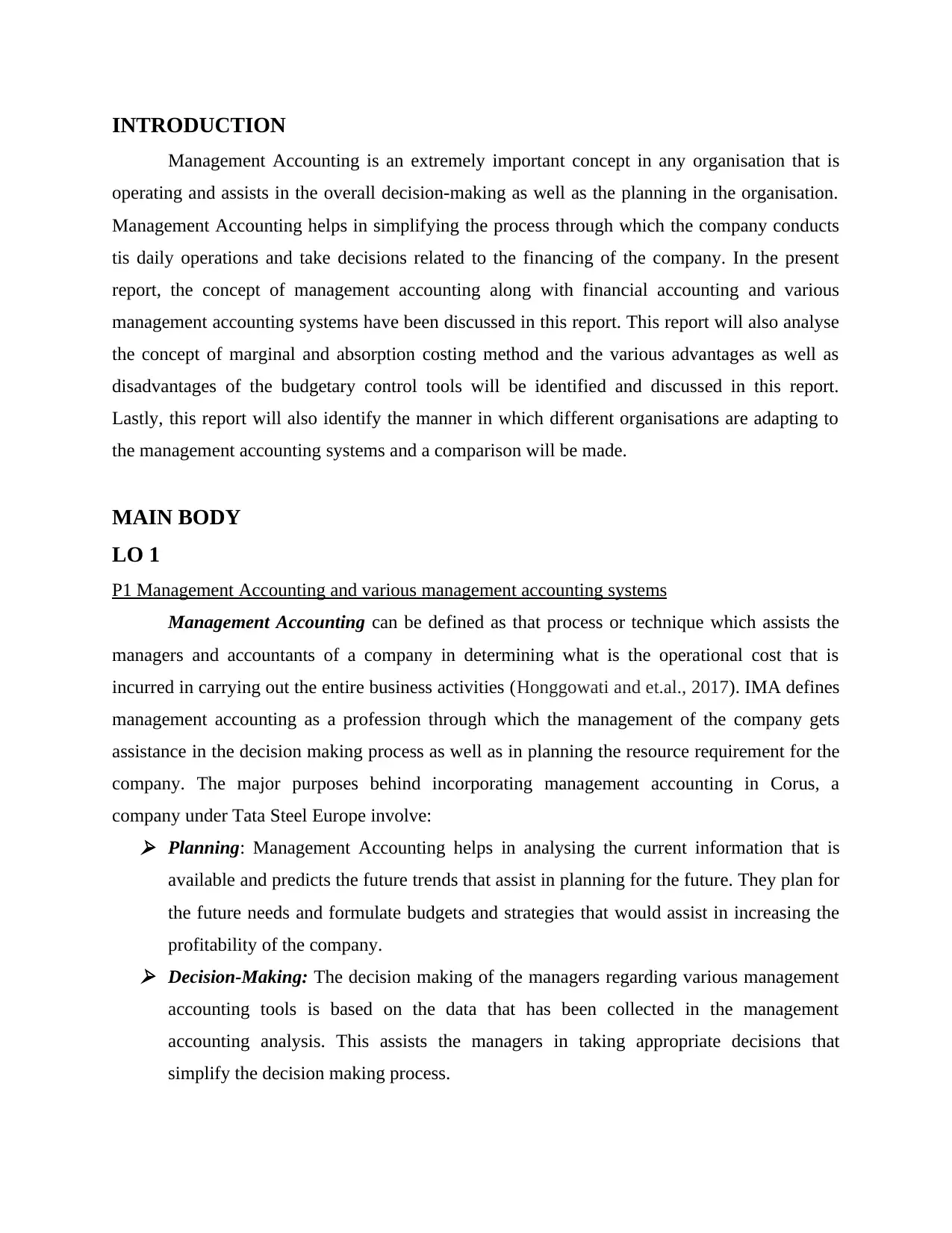
INTRODUCTION
Management Accounting is an extremely important concept in any organisation that is
operating and assists in the overall decision-making as well as the planning in the organisation.
Management Accounting helps in simplifying the process through which the company conducts
tis daily operations and take decisions related to the financing of the company. In the present
report, the concept of management accounting along with financial accounting and various
management accounting systems have been discussed in this report. This report will also analyse
the concept of marginal and absorption costing method and the various advantages as well as
disadvantages of the budgetary control tools will be identified and discussed in this report.
Lastly, this report will also identify the manner in which different organisations are adapting to
the management accounting systems and a comparison will be made.
MAIN BODY
LO 1
P1 Management Accounting and various management accounting systems
Management Accounting can be defined as that process or technique which assists the
managers and accountants of a company in determining what is the operational cost that is
incurred in carrying out the entire business activities (Honggowati and et.al., 2017). IMA defines
management accounting as a profession through which the management of the company gets
assistance in the decision making process as well as in planning the resource requirement for the
company. The major purposes behind incorporating management accounting in Corus, a
company under Tata Steel Europe involve: Planning: Management Accounting helps in analysing the current information that is
available and predicts the future trends that assist in planning for the future. They plan for
the future needs and formulate budgets and strategies that would assist in increasing the
profitability of the company. Decision-Making: The decision making of the managers regarding various management
accounting tools is based on the data that has been collected in the management
accounting analysis. This assists the managers in taking appropriate decisions that
simplify the decision making process.
Management Accounting is an extremely important concept in any organisation that is
operating and assists in the overall decision-making as well as the planning in the organisation.
Management Accounting helps in simplifying the process through which the company conducts
tis daily operations and take decisions related to the financing of the company. In the present
report, the concept of management accounting along with financial accounting and various
management accounting systems have been discussed in this report. This report will also analyse
the concept of marginal and absorption costing method and the various advantages as well as
disadvantages of the budgetary control tools will be identified and discussed in this report.
Lastly, this report will also identify the manner in which different organisations are adapting to
the management accounting systems and a comparison will be made.
MAIN BODY
LO 1
P1 Management Accounting and various management accounting systems
Management Accounting can be defined as that process or technique which assists the
managers and accountants of a company in determining what is the operational cost that is
incurred in carrying out the entire business activities (Honggowati and et.al., 2017). IMA defines
management accounting as a profession through which the management of the company gets
assistance in the decision making process as well as in planning the resource requirement for the
company. The major purposes behind incorporating management accounting in Corus, a
company under Tata Steel Europe involve: Planning: Management Accounting helps in analysing the current information that is
available and predicts the future trends that assist in planning for the future. They plan for
the future needs and formulate budgets and strategies that would assist in increasing the
profitability of the company. Decision-Making: The decision making of the managers regarding various management
accounting tools is based on the data that has been collected in the management
accounting analysis. This assists the managers in taking appropriate decisions that
simplify the decision making process.
⊘ This is a preview!⊘
Do you want full access?
Subscribe today to unlock all pages.

Trusted by 1+ million students worldwide
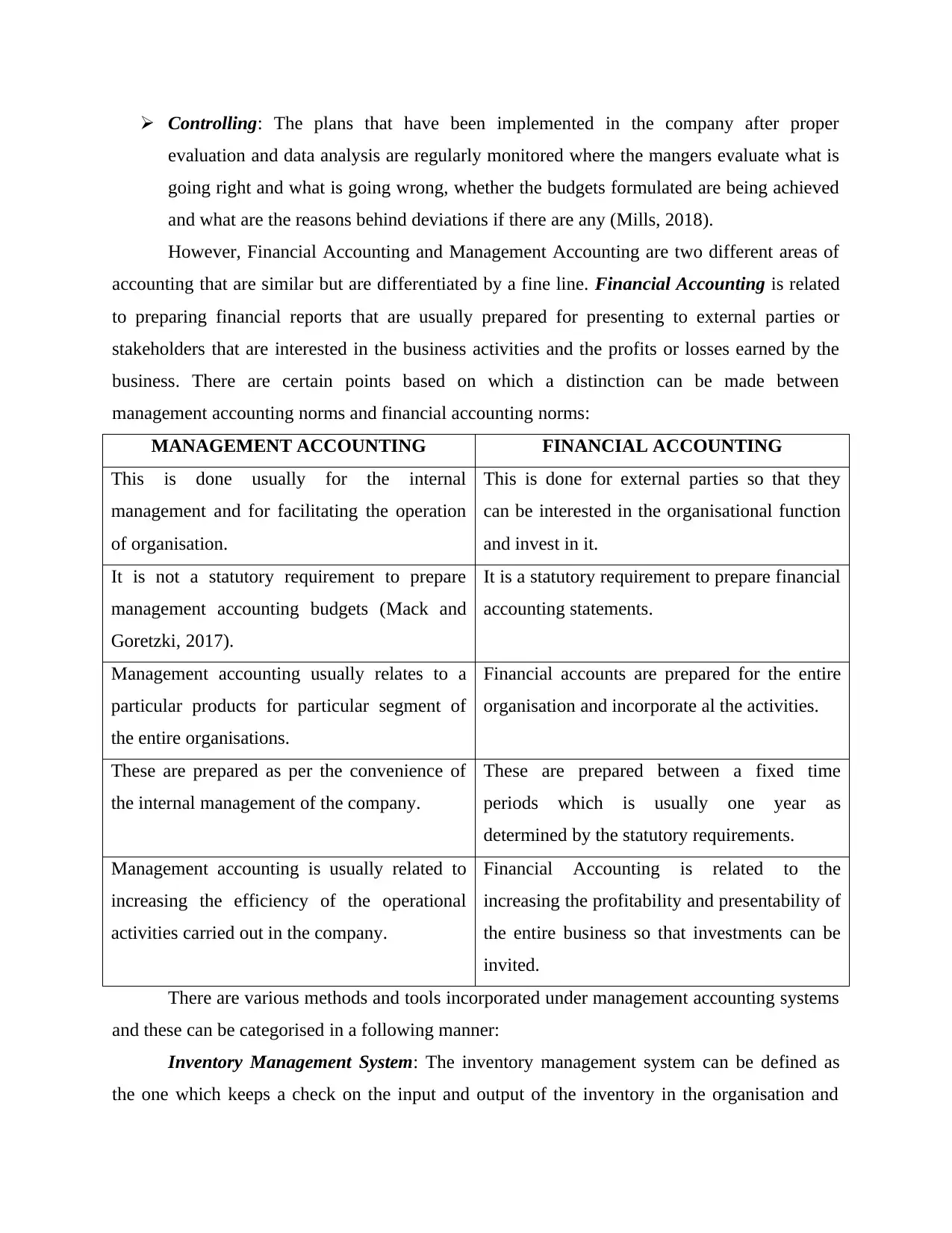
Controlling: The plans that have been implemented in the company after proper
evaluation and data analysis are regularly monitored where the mangers evaluate what is
going right and what is going wrong, whether the budgets formulated are being achieved
and what are the reasons behind deviations if there are any (Mills, 2018).
However, Financial Accounting and Management Accounting are two different areas of
accounting that are similar but are differentiated by a fine line. Financial Accounting is related
to preparing financial reports that are usually prepared for presenting to external parties or
stakeholders that are interested in the business activities and the profits or losses earned by the
business. There are certain points based on which a distinction can be made between
management accounting norms and financial accounting norms:
MANAGEMENT ACCOUNTING FINANCIAL ACCOUNTING
This is done usually for the internal
management and for facilitating the operation
of organisation.
This is done for external parties so that they
can be interested in the organisational function
and invest in it.
It is not a statutory requirement to prepare
management accounting budgets (Mack and
Goretzki, 2017).
It is a statutory requirement to prepare financial
accounting statements.
Management accounting usually relates to a
particular products for particular segment of
the entire organisations.
Financial accounts are prepared for the entire
organisation and incorporate al the activities.
These are prepared as per the convenience of
the internal management of the company.
These are prepared between a fixed time
periods which is usually one year as
determined by the statutory requirements.
Management accounting is usually related to
increasing the efficiency of the operational
activities carried out in the company.
Financial Accounting is related to the
increasing the profitability and presentability of
the entire business so that investments can be
invited.
There are various methods and tools incorporated under management accounting systems
and these can be categorised in a following manner:
Inventory Management System: The inventory management system can be defined as
the one which keeps a check on the input and output of the inventory in the organisation and
evaluation and data analysis are regularly monitored where the mangers evaluate what is
going right and what is going wrong, whether the budgets formulated are being achieved
and what are the reasons behind deviations if there are any (Mills, 2018).
However, Financial Accounting and Management Accounting are two different areas of
accounting that are similar but are differentiated by a fine line. Financial Accounting is related
to preparing financial reports that are usually prepared for presenting to external parties or
stakeholders that are interested in the business activities and the profits or losses earned by the
business. There are certain points based on which a distinction can be made between
management accounting norms and financial accounting norms:
MANAGEMENT ACCOUNTING FINANCIAL ACCOUNTING
This is done usually for the internal
management and for facilitating the operation
of organisation.
This is done for external parties so that they
can be interested in the organisational function
and invest in it.
It is not a statutory requirement to prepare
management accounting budgets (Mack and
Goretzki, 2017).
It is a statutory requirement to prepare financial
accounting statements.
Management accounting usually relates to a
particular products for particular segment of
the entire organisations.
Financial accounts are prepared for the entire
organisation and incorporate al the activities.
These are prepared as per the convenience of
the internal management of the company.
These are prepared between a fixed time
periods which is usually one year as
determined by the statutory requirements.
Management accounting is usually related to
increasing the efficiency of the operational
activities carried out in the company.
Financial Accounting is related to the
increasing the profitability and presentability of
the entire business so that investments can be
invited.
There are various methods and tools incorporated under management accounting systems
and these can be categorised in a following manner:
Inventory Management System: The inventory management system can be defined as
the one which keeps a check on the input and output of the inventory in the organisation and
Paraphrase This Document
Need a fresh take? Get an instant paraphrase of this document with our AI Paraphraser
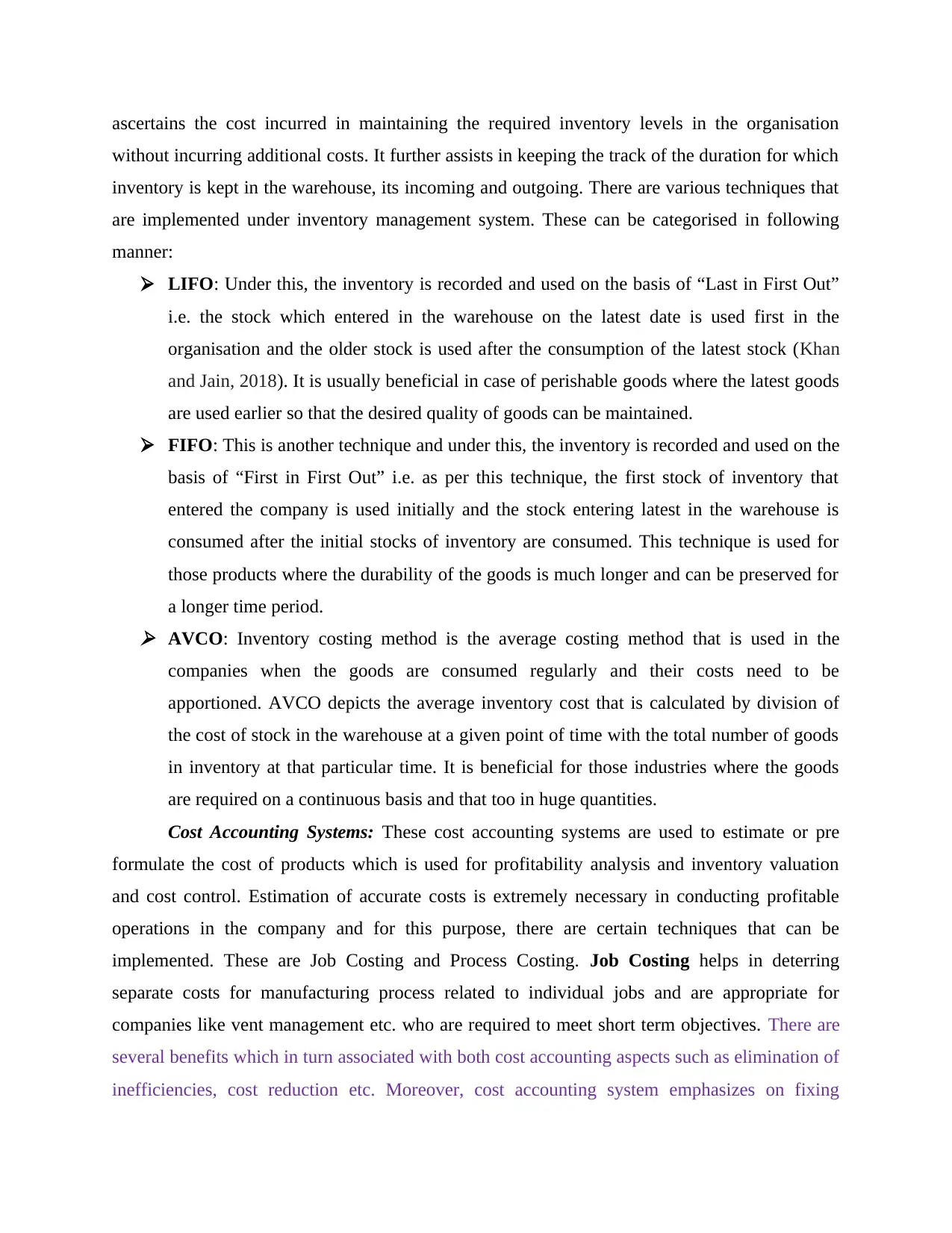
ascertains the cost incurred in maintaining the required inventory levels in the organisation
without incurring additional costs. It further assists in keeping the track of the duration for which
inventory is kept in the warehouse, its incoming and outgoing. There are various techniques that
are implemented under inventory management system. These can be categorised in following
manner:
LIFO: Under this, the inventory is recorded and used on the basis of “Last in First Out”
i.e. the stock which entered in the warehouse on the latest date is used first in the
organisation and the older stock is used after the consumption of the latest stock (Khan
and Jain, 2018). It is usually beneficial in case of perishable goods where the latest goods
are used earlier so that the desired quality of goods can be maintained.
FIFO: This is another technique and under this, the inventory is recorded and used on the
basis of “First in First Out” i.e. as per this technique, the first stock of inventory that
entered the company is used initially and the stock entering latest in the warehouse is
consumed after the initial stocks of inventory are consumed. This technique is used for
those products where the durability of the goods is much longer and can be preserved for
a longer time period. AVCO: Inventory costing method is the average costing method that is used in the
companies when the goods are consumed regularly and their costs need to be
apportioned. AVCO depicts the average inventory cost that is calculated by division of
the cost of stock in the warehouse at a given point of time with the total number of goods
in inventory at that particular time. It is beneficial for those industries where the goods
are required on a continuous basis and that too in huge quantities.
Cost Accounting Systems: These cost accounting systems are used to estimate or pre
formulate the cost of products which is used for profitability analysis and inventory valuation
and cost control. Estimation of accurate costs is extremely necessary in conducting profitable
operations in the company and for this purpose, there are certain techniques that can be
implemented. These are Job Costing and Process Costing. Job Costing helps in deterring
separate costs for manufacturing process related to individual jobs and are appropriate for
companies like vent management etc. who are required to meet short term objectives. There are
several benefits which in turn associated with both cost accounting aspects such as elimination of
inefficiencies, cost reduction etc. Moreover, cost accounting system emphasizes on fixing
without incurring additional costs. It further assists in keeping the track of the duration for which
inventory is kept in the warehouse, its incoming and outgoing. There are various techniques that
are implemented under inventory management system. These can be categorised in following
manner:
LIFO: Under this, the inventory is recorded and used on the basis of “Last in First Out”
i.e. the stock which entered in the warehouse on the latest date is used first in the
organisation and the older stock is used after the consumption of the latest stock (Khan
and Jain, 2018). It is usually beneficial in case of perishable goods where the latest goods
are used earlier so that the desired quality of goods can be maintained.
FIFO: This is another technique and under this, the inventory is recorded and used on the
basis of “First in First Out” i.e. as per this technique, the first stock of inventory that
entered the company is used initially and the stock entering latest in the warehouse is
consumed after the initial stocks of inventory are consumed. This technique is used for
those products where the durability of the goods is much longer and can be preserved for
a longer time period. AVCO: Inventory costing method is the average costing method that is used in the
companies when the goods are consumed regularly and their costs need to be
apportioned. AVCO depicts the average inventory cost that is calculated by division of
the cost of stock in the warehouse at a given point of time with the total number of goods
in inventory at that particular time. It is beneficial for those industries where the goods
are required on a continuous basis and that too in huge quantities.
Cost Accounting Systems: These cost accounting systems are used to estimate or pre
formulate the cost of products which is used for profitability analysis and inventory valuation
and cost control. Estimation of accurate costs is extremely necessary in conducting profitable
operations in the company and for this purpose, there are certain techniques that can be
implemented. These are Job Costing and Process Costing. Job Costing helps in deterring
separate costs for manufacturing process related to individual jobs and are appropriate for
companies like vent management etc. who are required to meet short term objectives. There are
several benefits which in turn associated with both cost accounting aspects such as elimination of
inefficiencies, cost reduction etc. Moreover, cost accounting system emphasizes on fixing
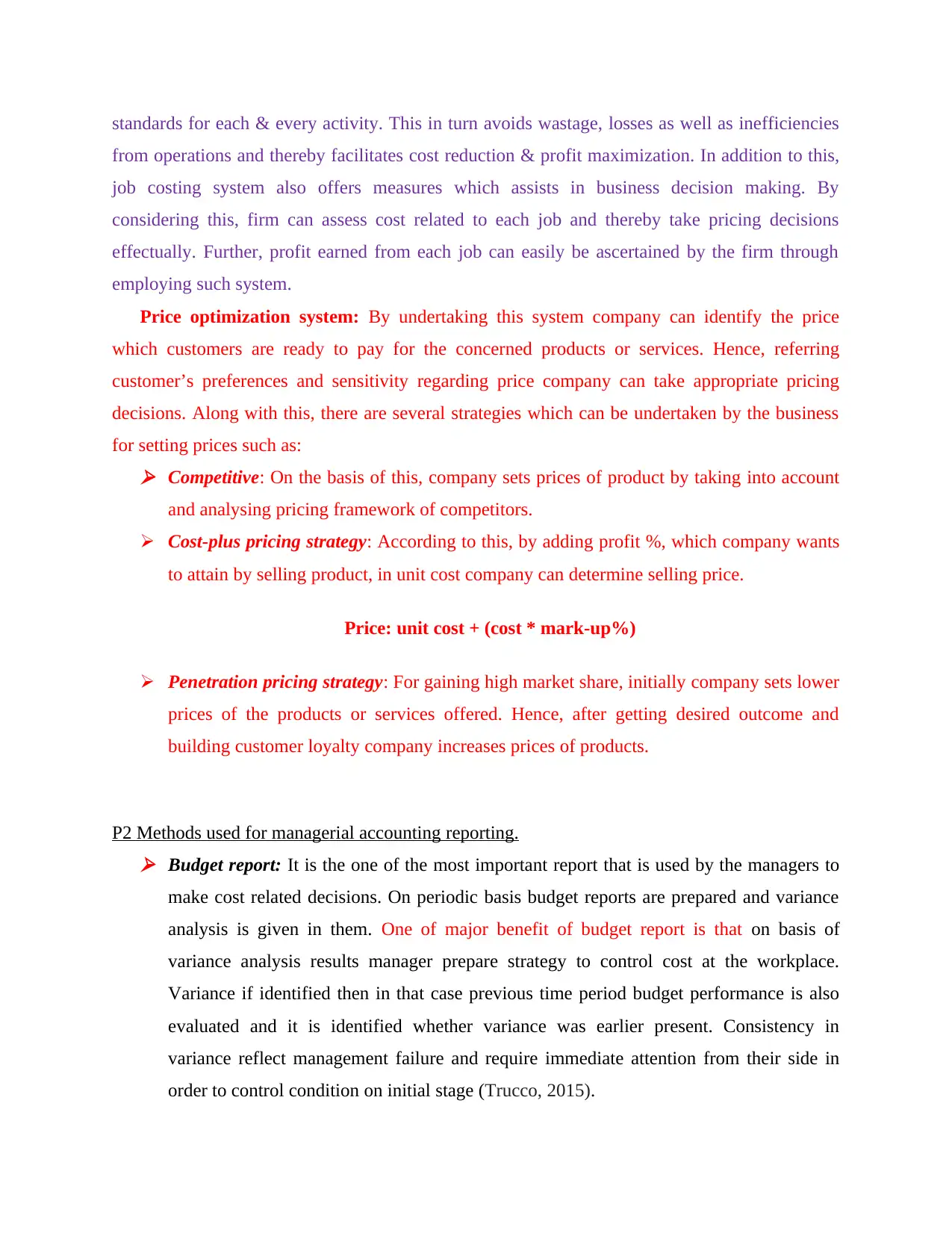
standards for each & every activity. This in turn avoids wastage, losses as well as inefficiencies
from operations and thereby facilitates cost reduction & profit maximization. In addition to this,
job costing system also offers measures which assists in business decision making. By
considering this, firm can assess cost related to each job and thereby take pricing decisions
effectually. Further, profit earned from each job can easily be ascertained by the firm through
employing such system.
Price optimization system: By undertaking this system company can identify the price
which customers are ready to pay for the concerned products or services. Hence, referring
customer’s preferences and sensitivity regarding price company can take appropriate pricing
decisions. Along with this, there are several strategies which can be undertaken by the business
for setting prices such as: Competitive: On the basis of this, company sets prices of product by taking into account
and analysing pricing framework of competitors.
Cost-plus pricing strategy: According to this, by adding profit %, which company wants
to attain by selling product, in unit cost company can determine selling price.
Price: unit cost + (cost * mark-up%)
Penetration pricing strategy: For gaining high market share, initially company sets lower
prices of the products or services offered. Hence, after getting desired outcome and
building customer loyalty company increases prices of products.
P2 Methods used for managerial accounting reporting. Budget report: It is the one of the most important report that is used by the managers to
make cost related decisions. On periodic basis budget reports are prepared and variance
analysis is given in them. One of major benefit of budget report is that on basis of
variance analysis results manager prepare strategy to control cost at the workplace.
Variance if identified then in that case previous time period budget performance is also
evaluated and it is identified whether variance was earlier present. Consistency in
variance reflect management failure and require immediate attention from their side in
order to control condition on initial stage (Trucco, 2015).
from operations and thereby facilitates cost reduction & profit maximization. In addition to this,
job costing system also offers measures which assists in business decision making. By
considering this, firm can assess cost related to each job and thereby take pricing decisions
effectually. Further, profit earned from each job can easily be ascertained by the firm through
employing such system.
Price optimization system: By undertaking this system company can identify the price
which customers are ready to pay for the concerned products or services. Hence, referring
customer’s preferences and sensitivity regarding price company can take appropriate pricing
decisions. Along with this, there are several strategies which can be undertaken by the business
for setting prices such as: Competitive: On the basis of this, company sets prices of product by taking into account
and analysing pricing framework of competitors.
Cost-plus pricing strategy: According to this, by adding profit %, which company wants
to attain by selling product, in unit cost company can determine selling price.
Price: unit cost + (cost * mark-up%)
Penetration pricing strategy: For gaining high market share, initially company sets lower
prices of the products or services offered. Hence, after getting desired outcome and
building customer loyalty company increases prices of products.
P2 Methods used for managerial accounting reporting. Budget report: It is the one of the most important report that is used by the managers to
make cost related decisions. On periodic basis budget reports are prepared and variance
analysis is given in them. One of major benefit of budget report is that on basis of
variance analysis results manager prepare strategy to control cost at the workplace.
Variance if identified then in that case previous time period budget performance is also
evaluated and it is identified whether variance was earlier present. Consistency in
variance reflect management failure and require immediate attention from their side in
order to control condition on initial stage (Trucco, 2015).
⊘ This is a preview!⊘
Do you want full access?
Subscribe today to unlock all pages.

Trusted by 1+ million students worldwide
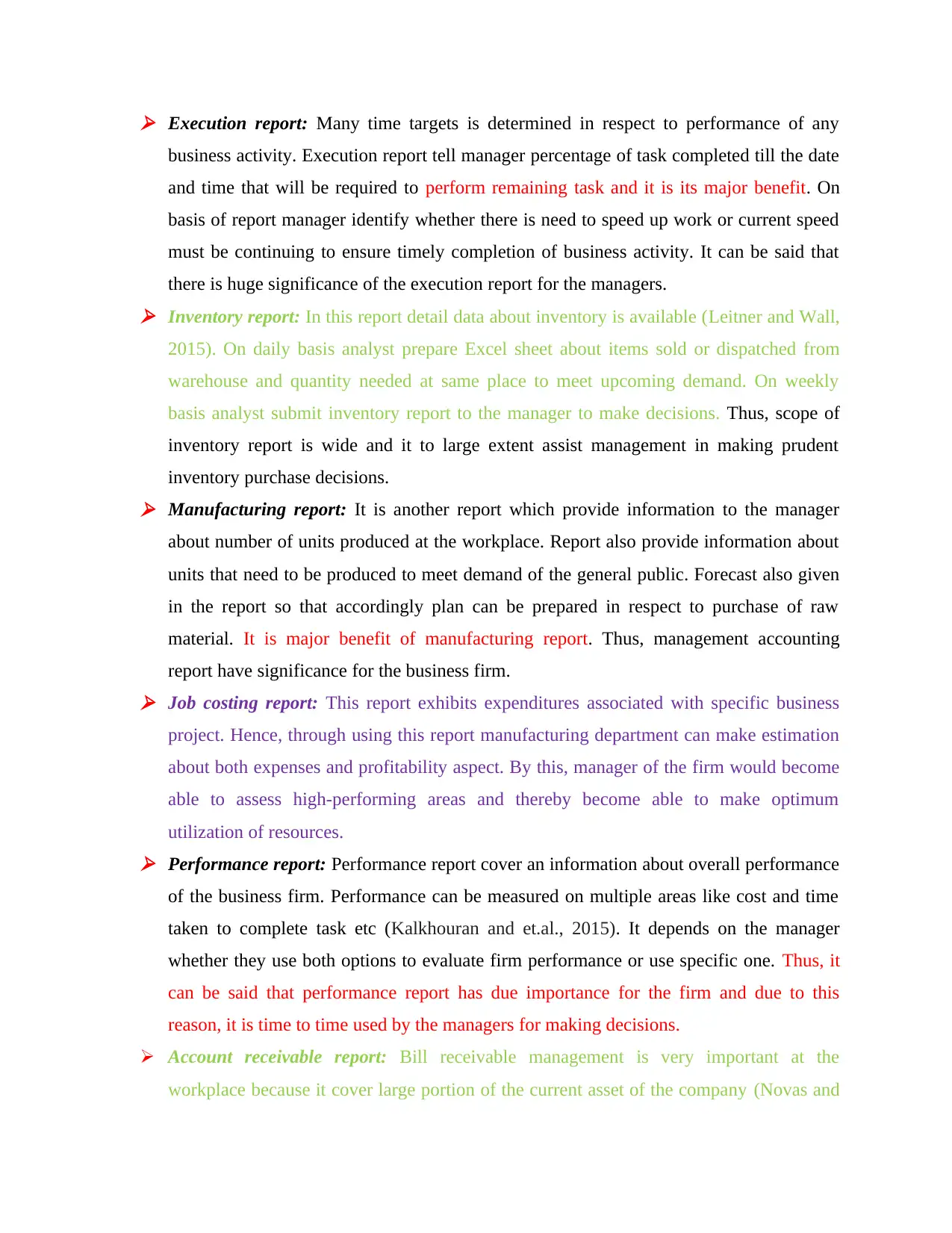
Execution report: Many time targets is determined in respect to performance of any
business activity. Execution report tell manager percentage of task completed till the date
and time that will be required to perform remaining task and it is its major benefit. On
basis of report manager identify whether there is need to speed up work or current speed
must be continuing to ensure timely completion of business activity. It can be said that
there is huge significance of the execution report for the managers. Inventory report: In this report detail data about inventory is available (Leitner and Wall,
2015). On daily basis analyst prepare Excel sheet about items sold or dispatched from
warehouse and quantity needed at same place to meet upcoming demand. On weekly
basis analyst submit inventory report to the manager to make decisions. Thus, scope of
inventory report is wide and it to large extent assist management in making prudent
inventory purchase decisions. Manufacturing report: It is another report which provide information to the manager
about number of units produced at the workplace. Report also provide information about
units that need to be produced to meet demand of the general public. Forecast also given
in the report so that accordingly plan can be prepared in respect to purchase of raw
material. It is major benefit of manufacturing report. Thus, management accounting
report have significance for the business firm. Job costing report: This report exhibits expenditures associated with specific business
project. Hence, through using this report manufacturing department can make estimation
about both expenses and profitability aspect. By this, manager of the firm would become
able to assess high-performing areas and thereby become able to make optimum
utilization of resources. Performance report: Performance report cover an information about overall performance
of the business firm. Performance can be measured on multiple areas like cost and time
taken to complete task etc (Kalkhouran and et.al., 2015). It depends on the manager
whether they use both options to evaluate firm performance or use specific one. Thus, it
can be said that performance report has due importance for the firm and due to this
reason, it is time to time used by the managers for making decisions.
Account receivable report: Bill receivable management is very important at the
workplace because it cover large portion of the current asset of the company (Novas and
business activity. Execution report tell manager percentage of task completed till the date
and time that will be required to perform remaining task and it is its major benefit. On
basis of report manager identify whether there is need to speed up work or current speed
must be continuing to ensure timely completion of business activity. It can be said that
there is huge significance of the execution report for the managers. Inventory report: In this report detail data about inventory is available (Leitner and Wall,
2015). On daily basis analyst prepare Excel sheet about items sold or dispatched from
warehouse and quantity needed at same place to meet upcoming demand. On weekly
basis analyst submit inventory report to the manager to make decisions. Thus, scope of
inventory report is wide and it to large extent assist management in making prudent
inventory purchase decisions. Manufacturing report: It is another report which provide information to the manager
about number of units produced at the workplace. Report also provide information about
units that need to be produced to meet demand of the general public. Forecast also given
in the report so that accordingly plan can be prepared in respect to purchase of raw
material. It is major benefit of manufacturing report. Thus, management accounting
report have significance for the business firm. Job costing report: This report exhibits expenditures associated with specific business
project. Hence, through using this report manufacturing department can make estimation
about both expenses and profitability aspect. By this, manager of the firm would become
able to assess high-performing areas and thereby become able to make optimum
utilization of resources. Performance report: Performance report cover an information about overall performance
of the business firm. Performance can be measured on multiple areas like cost and time
taken to complete task etc (Kalkhouran and et.al., 2015). It depends on the manager
whether they use both options to evaluate firm performance or use specific one. Thus, it
can be said that performance report has due importance for the firm and due to this
reason, it is time to time used by the managers for making decisions.
Account receivable report: Bill receivable management is very important at the
workplace because it cover large portion of the current asset of the company (Novas and
Paraphrase This Document
Need a fresh take? Get an instant paraphrase of this document with our AI Paraphraser
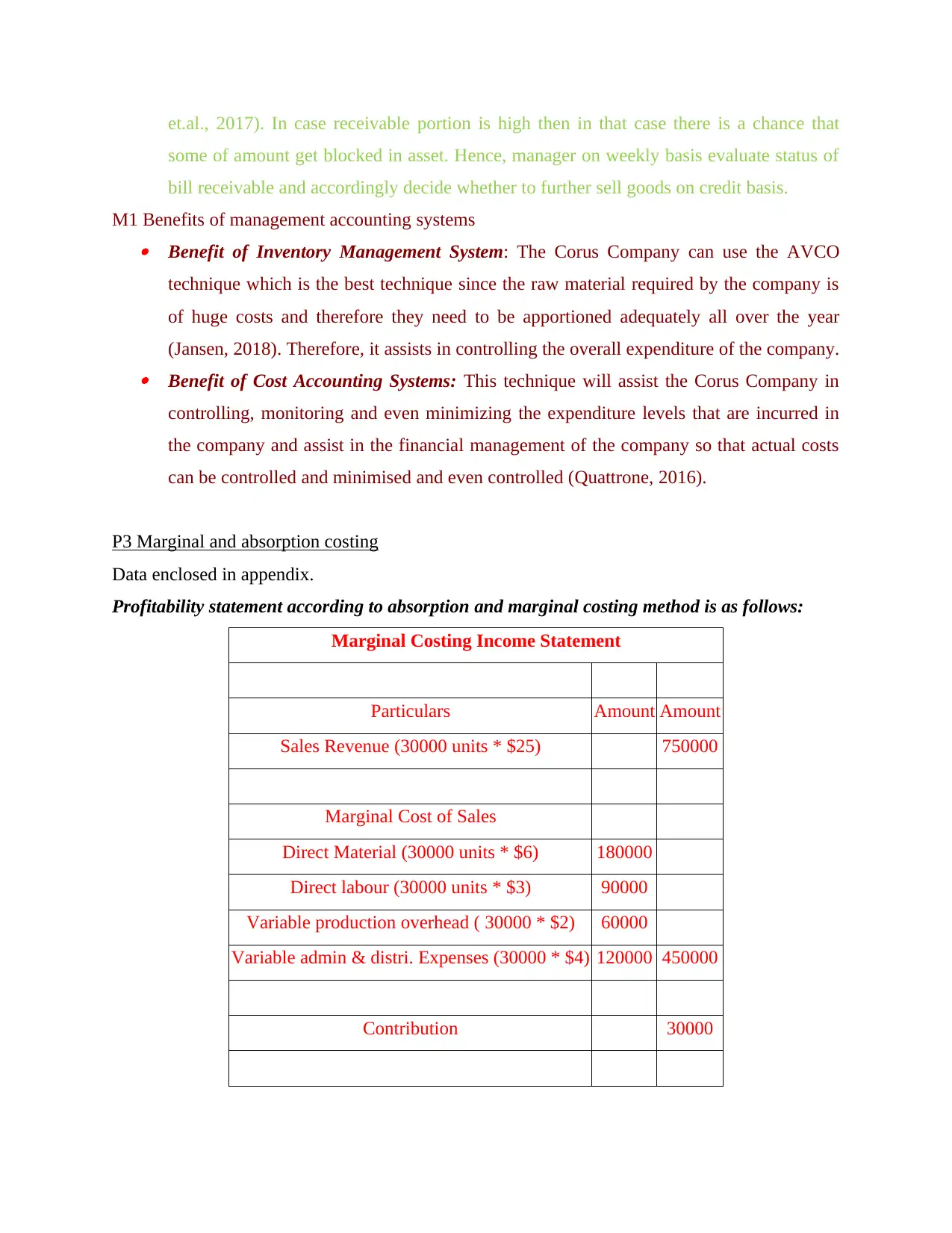
et.al., 2017). In case receivable portion is high then in that case there is a chance that
some of amount get blocked in asset. Hence, manager on weekly basis evaluate status of
bill receivable and accordingly decide whether to further sell goods on credit basis.
M1 Benefits of management accounting systems Benefit of Inventory Management System: The Corus Company can use the AVCO
technique which is the best technique since the raw material required by the company is
of huge costs and therefore they need to be apportioned adequately all over the year
(Jansen, 2018). Therefore, it assists in controlling the overall expenditure of the company. Benefit of Cost Accounting Systems: This technique will assist the Corus Company in
controlling, monitoring and even minimizing the expenditure levels that are incurred in
the company and assist in the financial management of the company so that actual costs
can be controlled and minimised and even controlled (Quattrone, 2016).
P3 Marginal and absorption costing
Data enclosed in appendix.
Profitability statement according to absorption and marginal costing method is as follows:
Marginal Costing Income Statement
Particulars Amount Amount
Sales Revenue (30000 units * $25) 750000
Marginal Cost of Sales
Direct Material (30000 units * $6) 180000
Direct labour (30000 units * $3) 90000
Variable production overhead ( 30000 * $2) 60000
Variable admin & distri. Expenses (30000 * $4) 120000 450000
Contribution 30000
some of amount get blocked in asset. Hence, manager on weekly basis evaluate status of
bill receivable and accordingly decide whether to further sell goods on credit basis.
M1 Benefits of management accounting systems Benefit of Inventory Management System: The Corus Company can use the AVCO
technique which is the best technique since the raw material required by the company is
of huge costs and therefore they need to be apportioned adequately all over the year
(Jansen, 2018). Therefore, it assists in controlling the overall expenditure of the company. Benefit of Cost Accounting Systems: This technique will assist the Corus Company in
controlling, monitoring and even minimizing the expenditure levels that are incurred in
the company and assist in the financial management of the company so that actual costs
can be controlled and minimised and even controlled (Quattrone, 2016).
P3 Marginal and absorption costing
Data enclosed in appendix.
Profitability statement according to absorption and marginal costing method is as follows:
Marginal Costing Income Statement
Particulars Amount Amount
Sales Revenue (30000 units * $25) 750000
Marginal Cost of Sales
Direct Material (30000 units * $6) 180000
Direct labour (30000 units * $3) 90000
Variable production overhead ( 30000 * $2) 60000
Variable admin & distri. Expenses (30000 * $4) 120000 450000
Contribution 30000
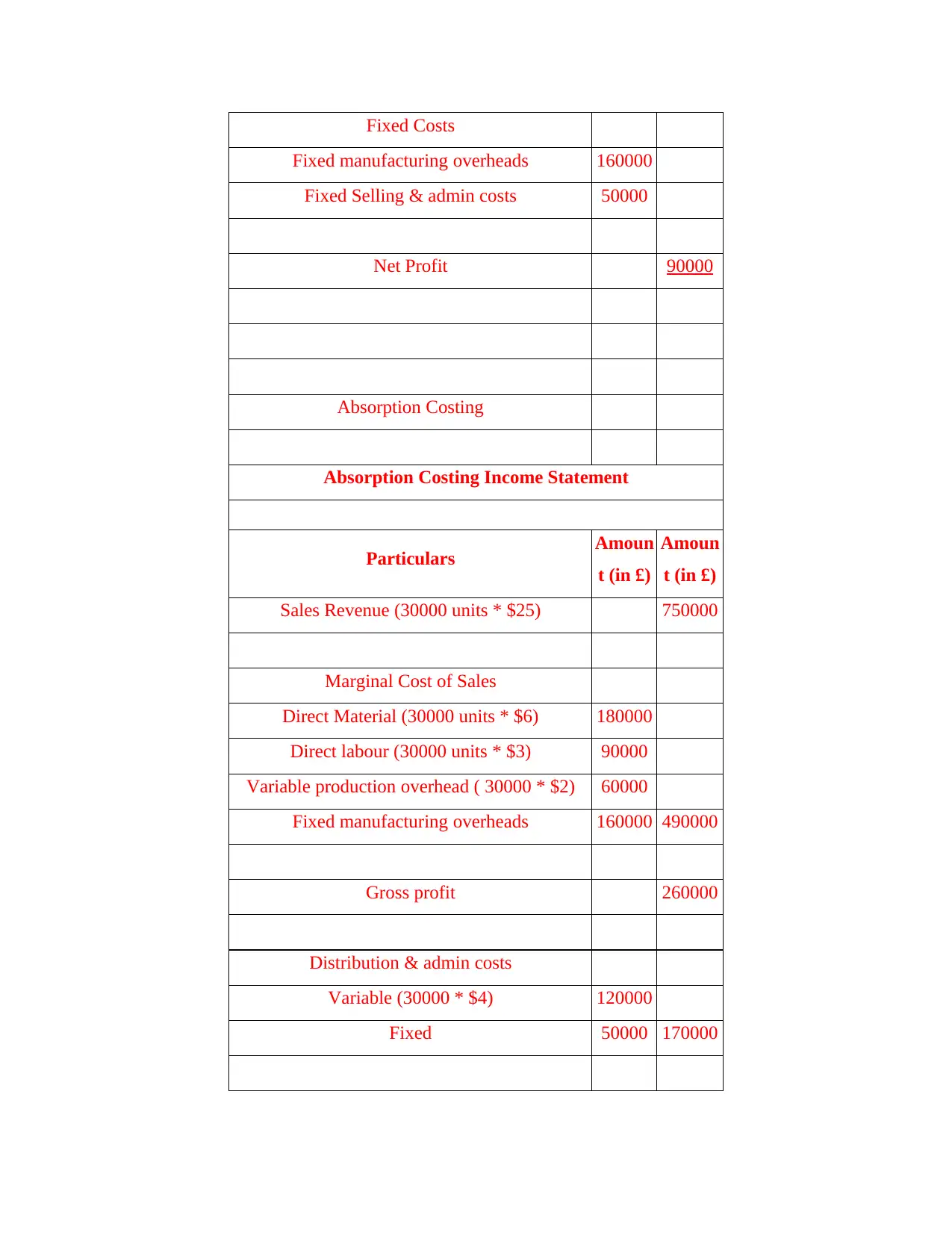
Fixed Costs
Fixed manufacturing overheads 160000
Fixed Selling & admin costs 50000
Net Profit 90000
Absorption Costing
Absorption Costing Income Statement
Particulars Amoun
t (in £)
Amoun
t (in £)
Sales Revenue (30000 units * $25) 750000
Marginal Cost of Sales
Direct Material (30000 units * $6) 180000
Direct labour (30000 units * $3) 90000
Variable production overhead ( 30000 * $2) 60000
Fixed manufacturing overheads 160000 490000
Gross profit 260000
Distribution & admin costs
Variable (30000 * $4) 120000
Fixed 50000 170000
Fixed manufacturing overheads 160000
Fixed Selling & admin costs 50000
Net Profit 90000
Absorption Costing
Absorption Costing Income Statement
Particulars Amoun
t (in £)
Amoun
t (in £)
Sales Revenue (30000 units * $25) 750000
Marginal Cost of Sales
Direct Material (30000 units * $6) 180000
Direct labour (30000 units * $3) 90000
Variable production overhead ( 30000 * $2) 60000
Fixed manufacturing overheads 160000 490000
Gross profit 260000
Distribution & admin costs
Variable (30000 * $4) 120000
Fixed 50000 170000
⊘ This is a preview!⊘
Do you want full access?
Subscribe today to unlock all pages.

Trusted by 1+ million students worldwide
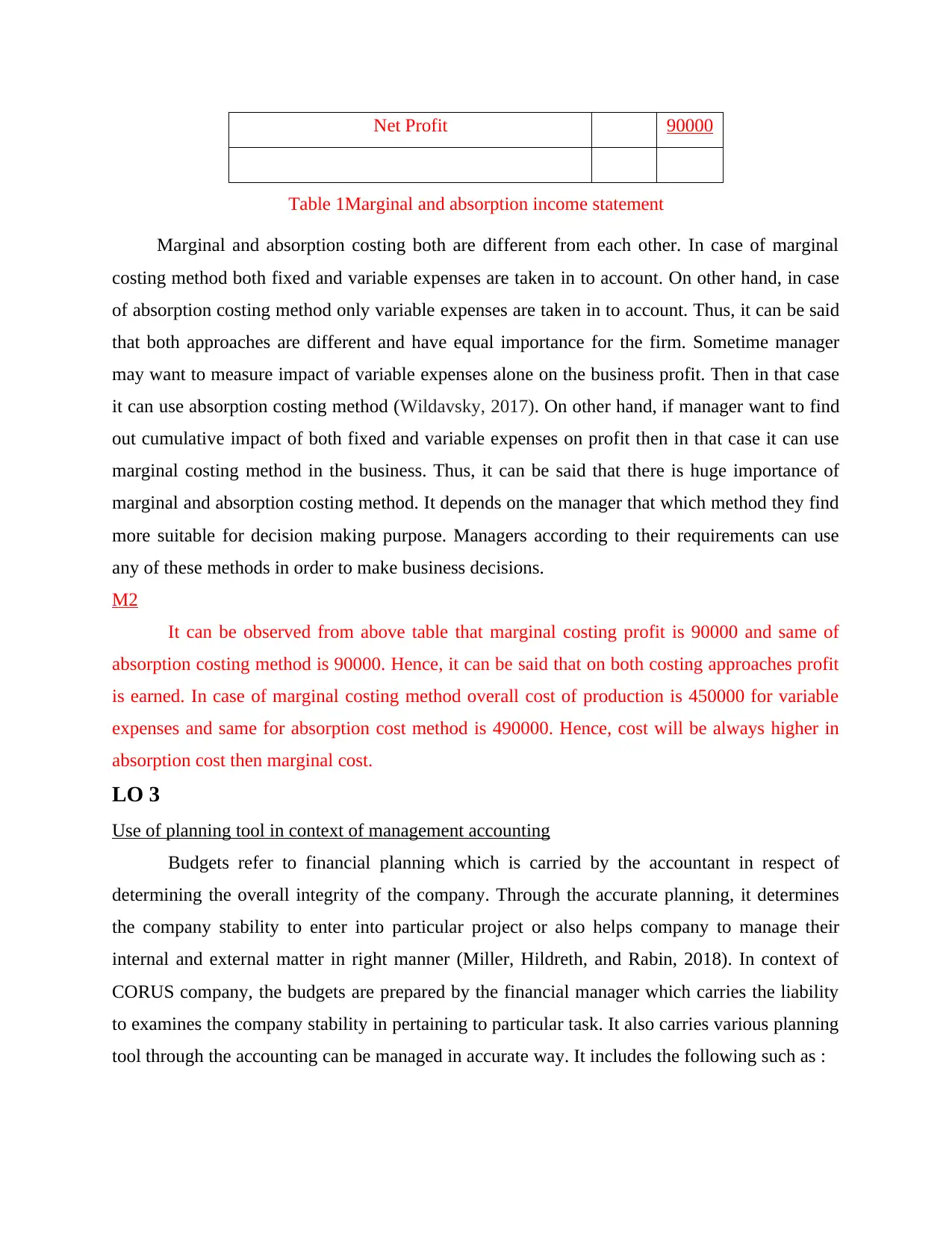
Net Profit 90000
Table 1Marginal and absorption income statement
Marginal and absorption costing both are different from each other. In case of marginal
costing method both fixed and variable expenses are taken in to account. On other hand, in case
of absorption costing method only variable expenses are taken in to account. Thus, it can be said
that both approaches are different and have equal importance for the firm. Sometime manager
may want to measure impact of variable expenses alone on the business profit. Then in that case
it can use absorption costing method (Wildavsky, 2017). On other hand, if manager want to find
out cumulative impact of both fixed and variable expenses on profit then in that case it can use
marginal costing method in the business. Thus, it can be said that there is huge importance of
marginal and absorption costing method. It depends on the manager that which method they find
more suitable for decision making purpose. Managers according to their requirements can use
any of these methods in order to make business decisions.
M2
It can be observed from above table that marginal costing profit is 90000 and same of
absorption costing method is 90000. Hence, it can be said that on both costing approaches profit
is earned. In case of marginal costing method overall cost of production is 450000 for variable
expenses and same for absorption cost method is 490000. Hence, cost will be always higher in
absorption cost then marginal cost.
LO 3
Use of planning tool in context of management accounting
Budgets refer to financial planning which is carried by the accountant in respect of
determining the overall integrity of the company. Through the accurate planning, it determines
the company stability to enter into particular project or also helps company to manage their
internal and external matter in right manner (Miller, Hildreth, and Rabin, 2018). In context of
CORUS company, the budgets are prepared by the financial manager which carries the liability
to examines the company stability in pertaining to particular task. It also carries various planning
tool through the accounting can be managed in accurate way. It includes the following such as :
Table 1Marginal and absorption income statement
Marginal and absorption costing both are different from each other. In case of marginal
costing method both fixed and variable expenses are taken in to account. On other hand, in case
of absorption costing method only variable expenses are taken in to account. Thus, it can be said
that both approaches are different and have equal importance for the firm. Sometime manager
may want to measure impact of variable expenses alone on the business profit. Then in that case
it can use absorption costing method (Wildavsky, 2017). On other hand, if manager want to find
out cumulative impact of both fixed and variable expenses on profit then in that case it can use
marginal costing method in the business. Thus, it can be said that there is huge importance of
marginal and absorption costing method. It depends on the manager that which method they find
more suitable for decision making purpose. Managers according to their requirements can use
any of these methods in order to make business decisions.
M2
It can be observed from above table that marginal costing profit is 90000 and same of
absorption costing method is 90000. Hence, it can be said that on both costing approaches profit
is earned. In case of marginal costing method overall cost of production is 450000 for variable
expenses and same for absorption cost method is 490000. Hence, cost will be always higher in
absorption cost then marginal cost.
LO 3
Use of planning tool in context of management accounting
Budgets refer to financial planning which is carried by the accountant in respect of
determining the overall integrity of the company. Through the accurate planning, it determines
the company stability to enter into particular project or also helps company to manage their
internal and external matter in right manner (Miller, Hildreth, and Rabin, 2018). In context of
CORUS company, the budgets are prepared by the financial manager which carries the liability
to examines the company stability in pertaining to particular task. It also carries various planning
tool through the accounting can be managed in accurate way. It includes the following such as :
Paraphrase This Document
Need a fresh take? Get an instant paraphrase of this document with our AI Paraphraser
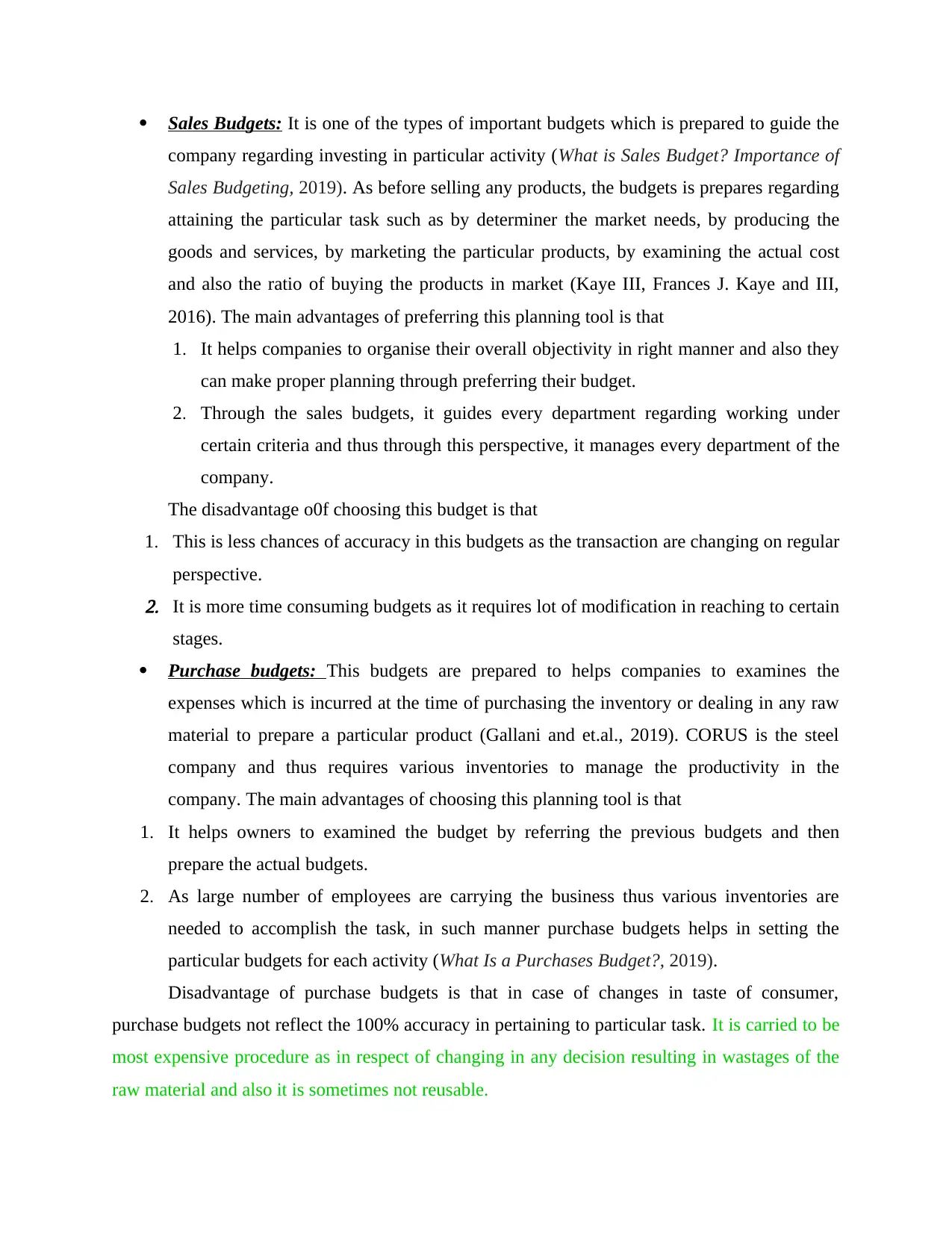
Sales Budgets: It is one of the types of important budgets which is prepared to guide the
company regarding investing in particular activity (What is Sales Budget? Importance of
Sales Budgeting, 2019). As before selling any products, the budgets is prepares regarding
attaining the particular task such as by determiner the market needs, by producing the
goods and services, by marketing the particular products, by examining the actual cost
and also the ratio of buying the products in market (Kaye III, Frances J. Kaye and III,
2016). The main advantages of preferring this planning tool is that
1. It helps companies to organise their overall objectivity in right manner and also they
can make proper planning through preferring their budget.
2. Through the sales budgets, it guides every department regarding working under
certain criteria and thus through this perspective, it manages every department of the
company.
The disadvantage o0f choosing this budget is that
1. This is less chances of accuracy in this budgets as the transaction are changing on regular
perspective.2. It is more time consuming budgets as it requires lot of modification in reaching to certain
stages.
Purchase budgets: This budgets are prepared to helps companies to examines the
expenses which is incurred at the time of purchasing the inventory or dealing in any raw
material to prepare a particular product (Gallani and et.al., 2019). CORUS is the steel
company and thus requires various inventories to manage the productivity in the
company. The main advantages of choosing this planning tool is that
1. It helps owners to examined the budget by referring the previous budgets and then
prepare the actual budgets.
2. As large number of employees are carrying the business thus various inventories are
needed to accomplish the task, in such manner purchase budgets helps in setting the
particular budgets for each activity (What Is a Purchases Budget?, 2019).
Disadvantage of purchase budgets is that in case of changes in taste of consumer,
purchase budgets not reflect the 100% accuracy in pertaining to particular task. It is carried to be
most expensive procedure as in respect of changing in any decision resulting in wastages of the
raw material and also it is sometimes not reusable.
company regarding investing in particular activity (What is Sales Budget? Importance of
Sales Budgeting, 2019). As before selling any products, the budgets is prepares regarding
attaining the particular task such as by determiner the market needs, by producing the
goods and services, by marketing the particular products, by examining the actual cost
and also the ratio of buying the products in market (Kaye III, Frances J. Kaye and III,
2016). The main advantages of preferring this planning tool is that
1. It helps companies to organise their overall objectivity in right manner and also they
can make proper planning through preferring their budget.
2. Through the sales budgets, it guides every department regarding working under
certain criteria and thus through this perspective, it manages every department of the
company.
The disadvantage o0f choosing this budget is that
1. This is less chances of accuracy in this budgets as the transaction are changing on regular
perspective.2. It is more time consuming budgets as it requires lot of modification in reaching to certain
stages.
Purchase budgets: This budgets are prepared to helps companies to examines the
expenses which is incurred at the time of purchasing the inventory or dealing in any raw
material to prepare a particular product (Gallani and et.al., 2019). CORUS is the steel
company and thus requires various inventories to manage the productivity in the
company. The main advantages of choosing this planning tool is that
1. It helps owners to examined the budget by referring the previous budgets and then
prepare the actual budgets.
2. As large number of employees are carrying the business thus various inventories are
needed to accomplish the task, in such manner purchase budgets helps in setting the
particular budgets for each activity (What Is a Purchases Budget?, 2019).
Disadvantage of purchase budgets is that in case of changes in taste of consumer,
purchase budgets not reflect the 100% accuracy in pertaining to particular task. It is carried to be
most expensive procedure as in respect of changing in any decision resulting in wastages of the
raw material and also it is sometimes not reusable.
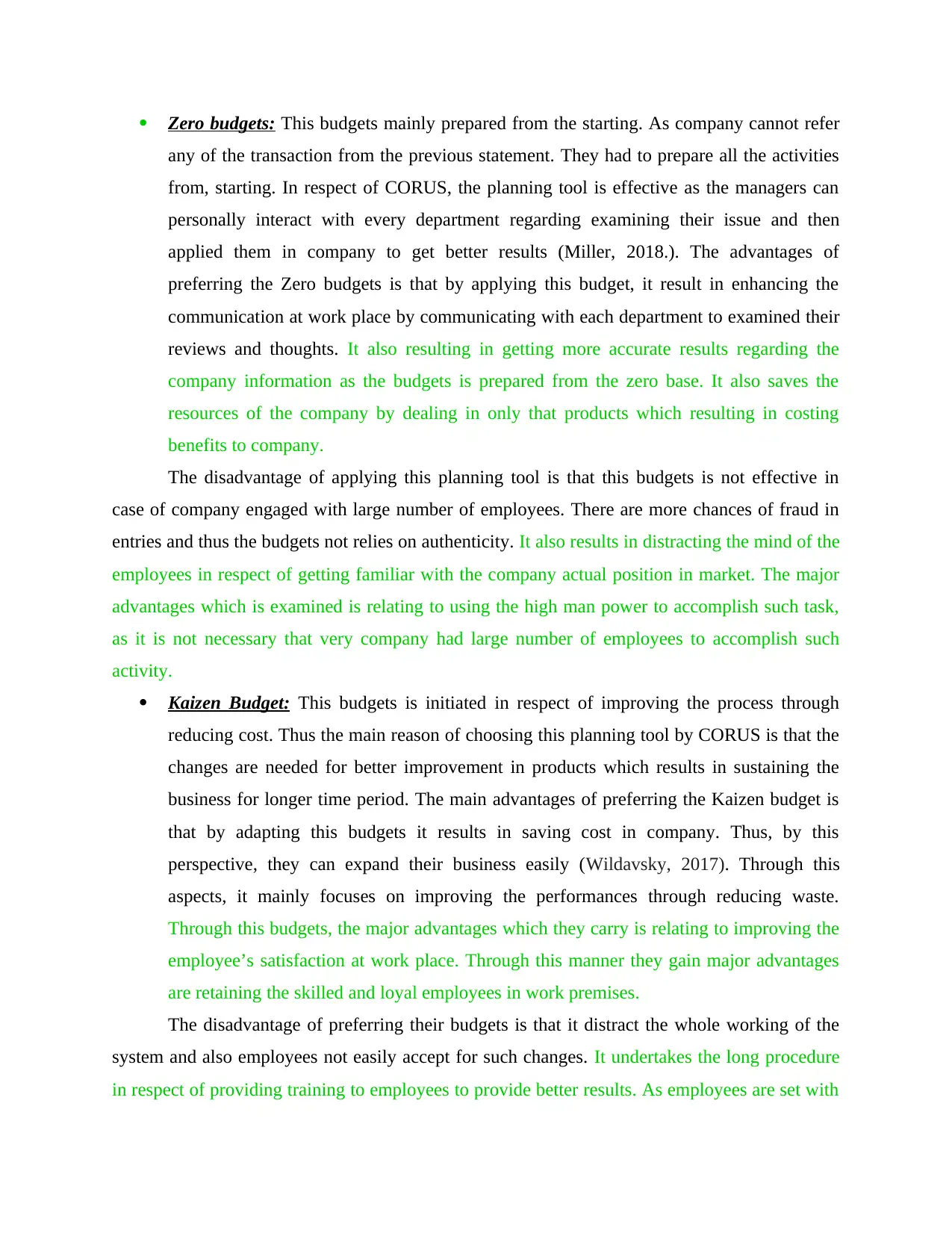
Zero budgets: This budgets mainly prepared from the starting. As company cannot refer
any of the transaction from the previous statement. They had to prepare all the activities
from, starting. In respect of CORUS, the planning tool is effective as the managers can
personally interact with every department regarding examining their issue and then
applied them in company to get better results (Miller, 2018.). The advantages of
preferring the Zero budgets is that by applying this budget, it result in enhancing the
communication at work place by communicating with each department to examined their
reviews and thoughts. It also resulting in getting more accurate results regarding the
company information as the budgets is prepared from the zero base. It also saves the
resources of the company by dealing in only that products which resulting in costing
benefits to company.
The disadvantage of applying this planning tool is that this budgets is not effective in
case of company engaged with large number of employees. There are more chances of fraud in
entries and thus the budgets not relies on authenticity. It also results in distracting the mind of the
employees in respect of getting familiar with the company actual position in market. The major
advantages which is examined is relating to using the high man power to accomplish such task,
as it is not necessary that very company had large number of employees to accomplish such
activity.
Kaizen Budget: This budgets is initiated in respect of improving the process through
reducing cost. Thus the main reason of choosing this planning tool by CORUS is that the
changes are needed for better improvement in products which results in sustaining the
business for longer time period. The main advantages of preferring the Kaizen budget is
that by adapting this budgets it results in saving cost in company. Thus, by this
perspective, they can expand their business easily (Wildavsky, 2017). Through this
aspects, it mainly focuses on improving the performances through reducing waste.
Through this budgets, the major advantages which they carry is relating to improving the
employee’s satisfaction at work place. Through this manner they gain major advantages
are retaining the skilled and loyal employees in work premises.
The disadvantage of preferring their budgets is that it distract the whole working of the
system and also employees not easily accept for such changes. It undertakes the long procedure
in respect of providing training to employees to provide better results. As employees are set with
any of the transaction from the previous statement. They had to prepare all the activities
from, starting. In respect of CORUS, the planning tool is effective as the managers can
personally interact with every department regarding examining their issue and then
applied them in company to get better results (Miller, 2018.). The advantages of
preferring the Zero budgets is that by applying this budget, it result in enhancing the
communication at work place by communicating with each department to examined their
reviews and thoughts. It also resulting in getting more accurate results regarding the
company information as the budgets is prepared from the zero base. It also saves the
resources of the company by dealing in only that products which resulting in costing
benefits to company.
The disadvantage of applying this planning tool is that this budgets is not effective in
case of company engaged with large number of employees. There are more chances of fraud in
entries and thus the budgets not relies on authenticity. It also results in distracting the mind of the
employees in respect of getting familiar with the company actual position in market. The major
advantages which is examined is relating to using the high man power to accomplish such task,
as it is not necessary that very company had large number of employees to accomplish such
activity.
Kaizen Budget: This budgets is initiated in respect of improving the process through
reducing cost. Thus the main reason of choosing this planning tool by CORUS is that the
changes are needed for better improvement in products which results in sustaining the
business for longer time period. The main advantages of preferring the Kaizen budget is
that by adapting this budgets it results in saving cost in company. Thus, by this
perspective, they can expand their business easily (Wildavsky, 2017). Through this
aspects, it mainly focuses on improving the performances through reducing waste.
Through this budgets, the major advantages which they carry is relating to improving the
employee’s satisfaction at work place. Through this manner they gain major advantages
are retaining the skilled and loyal employees in work premises.
The disadvantage of preferring their budgets is that it distract the whole working of the
system and also employees not easily accept for such changes. It undertakes the long procedure
in respect of providing training to employees to provide better results. As employees are set with
⊘ This is a preview!⊘
Do you want full access?
Subscribe today to unlock all pages.

Trusted by 1+ million students worldwide
1 out of 20
Related Documents
Your All-in-One AI-Powered Toolkit for Academic Success.
+13062052269
info@desklib.com
Available 24*7 on WhatsApp / Email
![[object Object]](/_next/static/media/star-bottom.7253800d.svg)
Unlock your academic potential
Copyright © 2020–2025 A2Z Services. All Rights Reserved. Developed and managed by ZUCOL.





